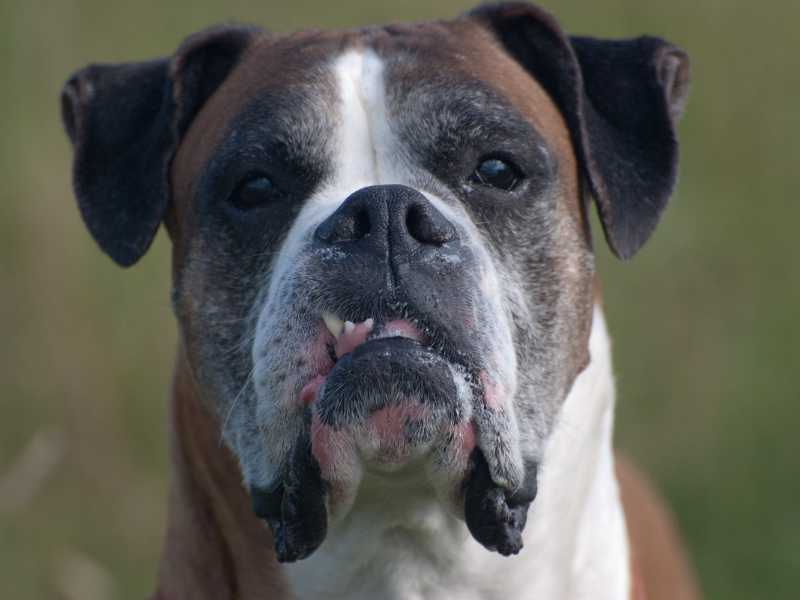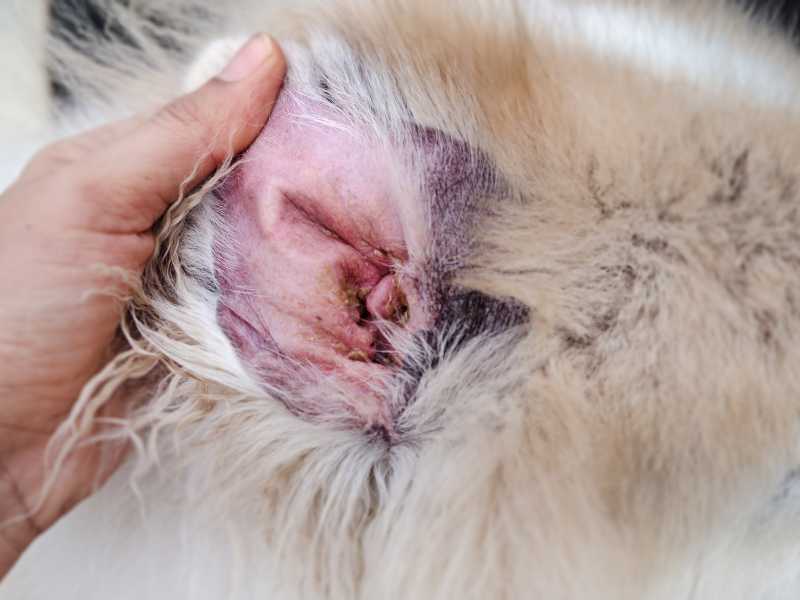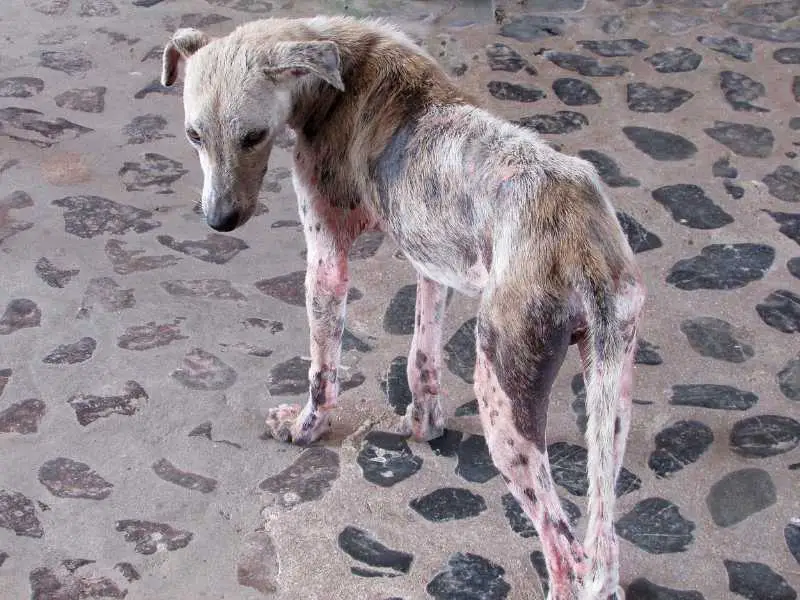Skin problems are a common concern among Boxer dog owners, and addressing them effectively is essential for their well-being. Ignoring or misunderstanding these skin issues can lead to discomfort and health complications for your beloved Boxer.

In this guide, we provide expert solutions and a comprehensive treatment guide for Boxer dog skin problems. By understanding these conditions and how to manage them, you can ensure your Boxer’s skin health and overall happiness. Let’s embark on a journey to keep your Boxer’s skin in its best condition.
Common Skin Problems in Boxer Dogs 🌡️

Allergies
Boxers are likely to have different types of allergies, which can seriously affect their health and comfort. These allergies often cause itching, red skin, rashes, ear infections, and stomach issues. Three main types of allergies commonly affect Boxers: food allergies, environmental allergies, and contact allergies.
Food Allergies
Food allergies are a common concern among Boxers, and they can develop sensitivities to certain ingredients in their diets. The top five allergens for dogs, including Boxers, are beef, dairy, chicken, wheat, and lamb. Symptoms of food allergies may include digestive problems like diarrhea or vomiting, as well as skin issues.
Environmental Allergies
Environmental allergies are another common issue for Boxer Dogs, triggered by things like pollen, house dust, and molds. These allergies often lead to itching, skin inflammation, and ear infections. Environmental allergies can be seasonal or year-round, depending on the specific allergen.
Contact Allergies
Contact allergies occur when Boxers come into direct contact with allergenic substances such as certain plants, cleaning products, or even fabrics. These allergies typically result in localized reactions on the skin, causing redness, itching, and sometimes hives. Identifying and eliminating the source of contact allergies is crucial for managing symptoms.
Preventive Measures
Managing allergies is important for Boxers. There are some simple things you can do to help prevent problems.
When it comes to food, be choosy about what goes in their bowl. Avoid common irritants like soy, wheat, corn, and dairy – those are guilty until proven innocent. Also, pass on artificially processed kibble and meats they’ve never tried before. Their tummy will thank you!
On the home front, do some regular cleaning to take care of dust mites and dirt. Give their space a good vacuum and make sure no mold or mildew is hanging around. And wash toys and beds frequently – you don’t wanna leave residues behind for them to sniff. Use anti-allergy bedding too.
During pollen season, think twice about letting them romp in trouble spots. Stick to indoor playdates if the pollen count is outrageous outside. Give ’em a bath regularly as well with mild hypoallergenic shampoo – that’ll wash away particles stuck to their fur.
If allergies seem to be popping up, talk to your vet. They can do testing to narrow it down and even immunotherapy treatment if it’s environmental stuff bugging them. Working with your vet is super important for customized care.
If prevention methods don’t do the trick, getting help from experts is the way to go. Taking simple steps at home could save your Boxer from a nasty season of sneezes!
Hot Spots (Pyotraumatic Dermatitis)
Hot spots, medically known as pyotraumatic dermatitis, are a common skin problem in Boxers. These are localized areas of skin inflammation and infection that can be quite uncomfortable for the dog. Hot spots can be triggered by various factors, including allergies, insect bites, poor grooming, and underlying skin conditions.
The signs and symptoms of hot spots are distinctive and often noticeable. Affected areas appear red, swollen, and moist, with oozing discharge and hair loss. The affected Boxer may continuously scratch, lick, or chew the area, exacerbating the problem.
Home care can help manage hot spots. Cleaning the affected area with a mild antiseptic solution and keeping it dry can promote healing. Applying a topical antibiotic or anti-inflammatory cream as prescribed by a veterinarian can also aid in recovery.
However, if a hot spot does not improve within 24-48 hours or worsens, it’s crucial to seek veterinary help promptly. A veterinarian may recommend oral antibiotics or steroids to address the infection and inflammation effectively. Identifying and addressing the underlying cause, such as allergies, is essential to prevent recurrent hot spots.
Dermatitis

Dermatitis is a broad term covering different types of skin inflammation, and Boxers can experience contact dermatitis, atopic dermatitis, and seborrheic dermatitis.
Contact dermatitis arises when a Boxer’s skin comes into direct contact with irritants or allergens, leading to localized redness, itching, and rashes. Common causes include certain plants, cleaning agents, and some fabrics.
Atopic dermatitis is a genetic predisposition to environmental allergens like pollen or dust mites, leading to chronic itching, redness, and skin irritation. It often requires long-term management and may be linked to other allergies, such as food sensitivities.
Seborrheic dermatitis involves the overproduction of skin oils, resulting in flaky or oily skin and often causing itching and discomfort. While the exact cause is not always clear, it can be exacerbated by underlying health conditions.
Treatment options for dermatitis in Boxers vary depending on the type and severity. They may include medicated shampoos, topical creams, and oral medications. Identifying and addressing potential triggers like fleas, irritants, or allergies is crucial for effective treatment and prevention.
To prevent dermatitis in Boxers, regular grooming, flea prevention, and minimizing exposure to known irritants are essential practices. Consulting a veterinarian for proper diagnosis and treatment guidance is crucial when dealing with dermatitis in Boxers.
Pyoderma
Pyoderma is a common skin problem among Boxer dogs, characterized by a bacterial skin infection. This condition can arise due to various factors, including allergies, parasites, and inadequate grooming. Pyoderma’s symptoms often show redness, swelling, pus-filled bumps, and hair loss on the affected areas of the skin.
Diagnosing pyoderma in Boxers typically involves a thorough physical exam by a veterinarian, including a close inspection of the skin and its lesions. In some cases, skin scraping may be done to confirm the presence of bacteria.
Treatment options for pyoderma in Boxers usually involve antibiotics, which may be prescribed orally or as topical creams or shampoos. The choice of treatment depends on the severity of the infection and the veterinarian’s assessment. Ensuring that the affected area is kept clean and dry can also aid in the healing process.
Malassezia Dermatitis
Malassezia dermatitis is a fungal skin infection that Boxers are likely to get. It is characterized by itching, redness, and flaky skin. This condition is often associated with an overgrowth of Malassezia yeast on the skin.
Treatment for Malassezia dermatitis typically involves medicated shampoos, topical creams, and sometimes, oral medications to combat the fungal overgrowth. The specific treatment plan will depend on the severity of the infection and the veterinarian’s recommendations.
Demodectic Mange

Demodectic mange is a skin problem that Boxers can develop due to an overgrowth of Demodex mites. These microscopic mites are naturally present on the skin but can multiply excessively, leading to symptoms such as hair loss, redness, and scaly skin.
The treatment of demodectic mange in Boxers usually includes medicated shampoos, topical creams, and oral medications to address the mite infestation and control the symptoms. Veterinary intervention may be necessary in more severe cases or if secondary infections occur.
Acne
Boxers can also experience acne, which typically appears on their chin and lips. This condition is primarily caused by clogged hair follicles and can be exacerbated by inadequate grooming.
Managing and preventing acne in Boxers involves regular grooming practices to keep the skin clean and free from debris. Additionally, using non-plastic food and water bowls can help reduce chin acne. Keeping the affected area clean and avoiding any harsh chemicals or irritating substances can contribute to preventing acne outbreaks.
Hives (Urticaria)
Hives, medically known as urticaria, are an uncommon but distressing skin problem in dogs, occasionally affecting Boxers. They manifest as raised red welts on the skin, often accompanied by itching, redness, and swelling.
Common triggers for hives in Boxers include insect bites, exposure to specific shampoos or medications, and contact with toxic substances. Prompt veterinary care is crucial when hives occur. It can include antihistamines, corticosteroids, and other medications to alleviate inflammation and itching.
In some cases, identifying and eliminating the underlying cause becomes necessary to prevent recurrence, highlighting the importance of early intervention and professional guidance.
Master Boxer Dog Weight Management with Our Comprehensive Owner’s Guide. Keep your beloved Boxer healthy and happy with expert advice.
Diagnosis and Veterinary Consultation 🏥

The Importance of Professional Evaluation
It cannot be stressed enough how important it is to involve a veterinarian when dealing with skin problems in Boxer dogs. Veterinarians have the knowledge and experience needed to diagnose and treat these issues accurately. The diagnostic process typically includes a thorough exam of your Boxer’s skin, sometimes involving skin tests and, in complex cases, biopsies. Relying on a veterinarian’s expertise makes sure you get an accurate diagnosis as well as the best treatment options. Delaying veterinary care when you suspect a skin problem can lead to the condition becoming worse and potentially developing into more serious health problems, underlining the importance of timely professional evaluation.
Questions to Ask the Vet
When talking to your veterinarian about your Boxer’s skin problem, it’s crucial to ask relevant questions to gain a complete understanding of the diagnosis and treatment plan. Here are some essential questions to ask during the consultation:
- What is the diagnosis, and what is causing my Boxer’s skin problem?
- Understanding the root cause is vital for effective treatment.
- What are the treatment options, and what are the potential side effects?
- Knowing the available treatments and their potential side effects allows you to make informed decisions.
- How long will treatment take, and what is the expected outcome?
- Having an estimate of the treatment duration and an understanding of the anticipated outcome helps manage expectations.
- Are there any long-term care recommendations or preventive measures?
- Learning about long-term care and preventive measures can contribute to your Boxer’s ongoing well-being.
- How can I manage my Boxer’s symptoms at home?
- Home care can play a significant role in a Boxer’s recovery, and guidance from your vet is invaluable.
- When should I schedule a follow-up appointment or seek veterinary help if the condition worsens?
- Having a clear plan for follow-up care ensures ongoing monitoring and timely intervention if needed.
Asking these questions will ensure that you are well-informed about your Boxer’s condition and have a clear plan for their treatment and care.
Treatment and Management 🩹
Medications
Medications play a crucial role in treating skin problems in Boxers, addressing both bacterial and fungal infections. When bacterial infections are present, vets often prescribe antibiotics like cephalexin and amoxicillin. For fungal infections, antifungal medications like ketoconazole or fluconazole may be recommended. Additionally, corticosteroids might be prescribed to reduce inflammation and itching, but they are typically used in short periods or at low doses to minimize potential side effects.
However, it’s important to note that some medications may have side effects, including stomach upset, increased thirst and urination, or changes in appetite. If your Boxer experiences any adverse reactions, promptly contact your veterinarian for guidance. Adhering to the prescribed medication schedule is crucial for effective treatment, as missing doses or discontinuing treatment too early can lead to ineffective results or a relapse of the condition.
Topical Treatments
Topical treatments are valuable for targeting specific areas of irritation or infection. Hypoallergenic shampoos containing ingredients like tea tree oil and aloe vera can soothe irritated skin. Typically, bathing your Boxer once or twice a week, or as recommended by your vet, can help manage skin issues. When applying topical treatments, it’s essential to follow your veterinarian’s instructions regarding the application method and frequency to achieve the best results.
Dietary Changes
Dietary changes can significantly impact the management of skin problems, especially when food allergies are suspected as a contributing factor. Transitioning your Boxer to a hypoallergenic diet, typically consisting of novel protein sources and limited ingredients, can help identify and manage food allergies. Research shows that more than 80% of patients achieved remission of clinical signs after five weeks of starting an elimination diet.
In addition to dietary adjustments, incorporating daily doses of Omega-3 fatty acids can contribute to your Boxer’s skin and coat health. You can provide Omega-3 fatty acids through fish oil supplements or by adding sources like salmon or flaxseed oil to your dog’s diet. This dietary enhancement can promote skin health and reduce the impact of skin problems on your Boxer’s overall well-being.
Discover 10 Fun Facts About the Boxer Dog 🐾. Get to know these playful and loyal companions on a whole new level!
Home Care and Prevention 🏡

Bathing and Grooming
Proper bathing and grooming are essential for Boxers with skin problems. When bathing your Boxer, opt for a hypoallergenic shampoo that contains soothing ingredients like tea tree oil and aloe vera. These components can help reduce skin irritation.
Regular grooming plays a crucial role in preventing skin issues. Brush your Boxer’s coat at least once a week to remove loose hair and debris. This not only keeps their coat healthy but also promotes better skin health. Furthermore, keeping your Boxer’s nails trimmed is important to prevent scratching and self-inflicted trauma to the skin.
Environmental Control
Creating an allergen-free environment is beneficial for Boxers prone to skin problems. To achieve this, consider vacuuming your home frequently to eliminate allergens. Regularly washing your Boxer’s bedding and toys can also help maintain a clean environment.
Using air purifiers in your home can aid in reducing allergens. Minimize your Boxer’s exposure to common triggers like pollen and dust by keeping them indoors during peak allergy seasons. Additionally, incorporating HEPA filters into your home’s ventilation system can reduce allergen levels.
Opt for hypoallergenic cleaning products, and avoid the use of scented candles or air fresheners, as these can exacerbate skin sensitivities.
Preventive Measures
Preventive measures are crucial in managing and avoiding skin problems in Boxers. Ensure you have a regular flea control regimen in place to prevent flea infestations, which can lead to skin problems.
Vaccinations also play a role in skin health, as they can help prevent specific skin conditions, such as demodectic mange. To maintain your Boxer’s skin and coat health, monitor them regularly for any changes or signs of irritation. Early intervention is key in preventing the development of more severe health issues related to skin problems.
By diligently following these home care and preventive measures, you can effectively manage your Boxer’s skin issues and contribute to their overall health and well-being.
When to Seek Immediate Veterinary Care
Recognizing when to seek immediate veterinary care for your Boxer is crucial. There are certain emergencies and severe symptoms that should not be ignored. In the case of swelling around the face or if your Boxer experiences difficulty breathing, it could indicate a severe allergic reaction or another critical issue that requires immediate attention.
If your Boxer’s skin problems worsen or persist beyond one or two weeks without any signs of improvement, it’s time to seek veterinary attention. Signs of infection, such as oozing, pus, or a foul odor coming from skin lesions, should be addressed urgently to prevent further complications.
Persistent and excessive scratching, licking, or biting of the skin can lead to more severe issues and should not be overlooked. Additionally, if your Boxer displays signs of pain or discomfort, such as whimpering, yelping, or reluctance to move, it could indicate a serious underlying problem that needs immediate veterinary assessment.
Recognizing these severe symptoms and acting promptly is vital. Delaying veterinary care in such situations can result in the progression of the condition and potentially life-threatening consequences. Your Boxer’s health and well-being should always be a top priority, so don’t hesitate to contact your veterinarian if you observe any of these concerning signs.
Explore the Boxer Growth and Weight Chart: From Puppy to Adulthood. Ensure your Boxer’s healthy development with our comprehensive guide.
Conclusion
In closing, being proactive, regular veterinary checkups, and quick action during severe symptoms are crucial for guaranteeing the skin health and overall well-being of your cherished Boxer friend. By staying knowledgeable and taking responsible steps, you can help your Boxer live a happy and itch-free life.
